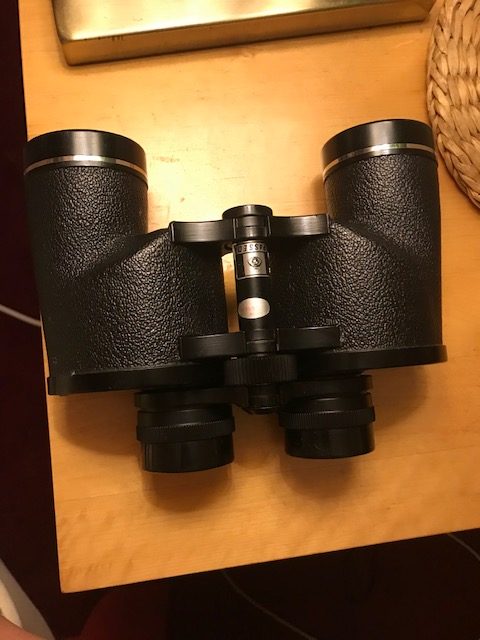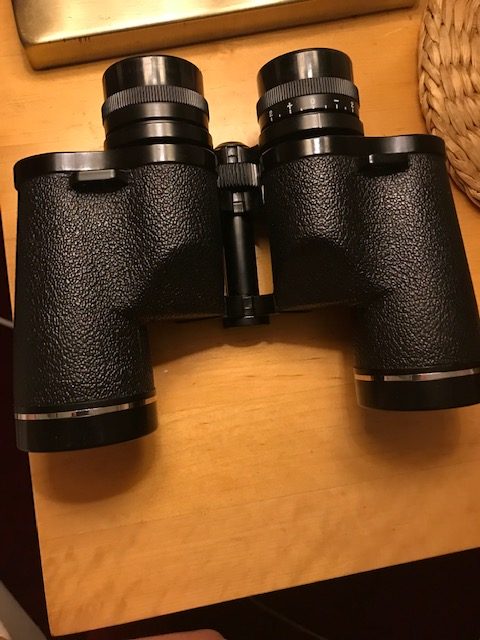
History merely repeats itself. It has all been done before. Nothing under the sun is truly new.
Ecclesiastes 1:9
A Work Commenced 18/6/23
“What on earth were these instruments designed for? “
That was the question I posed to myself as I first brought this old classic Japanese-made Asahi Pentax 8 x 40 wide field binocular to my eyes for the first time. The view had a very sharp central image and a huge 9.5-degree field of view for an 8x glass, but the image was tinged in a weird greenish cast. A quick google search brought up a few possibilities but the most common answer was that the special coatings applied to the ocular lenses acted like polaroid sunglasses cutting down on glare, especially on sunny days. But if that were so, what was the green tint all about? I mean, I’ve never had sunglasses that imparted a greenish tint to everything!?

I picked the instrument up from a chap on fleabay back in early March for £65 plus £6 shipping, so £71 all in. The condition of the instrument looked immaculate, especially for a 1970s vintage glass. The original leather carry case is beautifully made with a rose-coloured lining. When I received the instrument, I was amazed how pristine it was; really like brand new. This must have been stored somewhere warm and dry for decades Indeed, the only reason I could think of to explain its tip-top condition was that it was hardly used at all!

The build quality of this Asahi Pentax is very impressive. Good big prisms, with a nicely tensioned central focus wheel moving very smoothly after all these years. The objectives looked singly coated with the standard bluish glint of magnesium fluoride anti-reflection coating. The right eye dioptre moved very smoothly but with great resistance to accidental displacement, with an easy-to-read +/- scale. The eyecups are made from hard plastic and so can’t be adjusted to improve eye relief for the bespectacled, but I suppose some resourceful person could shim them down to access more of the field.

The instrument is extremely chunky, tipping the scales at 979g without a neck strap. I guess this was one of the instruments that helped stereotype the classic Porro as being big and bulky, although that’s not really true today I’m glad to say. I measured close focus at 6 yards – again stereotypical of glasses from this era but also no longer necessarily true today either. Using it for a few minutes,you really do come away with the impression that this was a quality instrument, especially when it saw first light all those decades ago. Based on the stampings on the front cap, this was manufactured by Zuiho Kogaku Seiki Co, Tokyo.

The eyepieces are coated with a substance that reflects golden light to the eye. It’s not gold however, in case you’re wondering. The wavelength of the reflected light (~600nm) only depends on the refractive index of the coating and its thickness. I’ve heard of some folk who have removed these coatings using acetone and a bit of elbow grease with varying degrees of success. Some reported that the colour cast of the resulting images are more natural but also that it exposed more internal reflections and glare in the images they served up.
The strong colour shift renders the Asahi Pentax almost useless for birding excursions. Accurate identification relies on the binocular delivering colours that are faithful to the natural image. It’s not especially good at cutting down on glare either. Turning the binocular on some strongly backlit scenes showed up significant glare in this instrument, as it also did when I turned it on a sodium streetlamp after dark. But what’s remarkable about this instrument is the expansive field of view with very good sharpness across most of the field. As an astronomical instrument, it also does quite well but the low light transmission and colour shift renders the images a bit dimmer than a modern instrument having superior coatings.
A well-corrected 9.5 degree field is very impressive for an 8x instrument though. It’s actually larger than my Nikon EII 8 x 30(~9 degrees) and my Nikon Action 7 x 35 ( 9.3 degrees). But when I began to study a variety of older Porro prism binoculars, especially in the 7 x 35 format, I was shocked by what I discovered. Paul Wehr, a keen binocular collector based in New York was kind enough to share some images of his extensive collection of classic Japanese-made 7 x 35s with me. It turns out that 9 or even 10-degree fields were rather on the small side. Take a look at some of the models in his collection.
Here are a couple of vintage Bushnell 7x 35 Rangemasters sporting 10 degree fields:

But they come significantly wider again. Take a look at this Swift Holiday Mark II with an 11 degree field:

Or how about this Sans & Streiffe 7 x 35 model with a whopping 13 degree true field!

My conversations with Paul made it obvious that he’s very impressed with these classic widefield binoculars. I would be too! Ultra wide fields like this are not unique to Porro prism models either. Take the Leica Amplivid 6 x 24, for example, sporting a 12 degree field.
Back to the Future
My personal ‘discovery’ of the existence of these ultrawide compact binocular models from yesteryear raises interesting questions in my mind. In 2023, leading binocular manufacturers like Swarovski and Zeiss wax lyrical about their wide-angle flagship models, like the NL Pure range and Victory SFs, sporting fields of the order of 9 degrees. Owners rave about their huge fields seemingly unaware that much bigger fields were available to binocular enthusiasts a half century ago.
There’s an important lesson to be learned here. Resurrecting these classic Porro prism designs with enormous fields could be done at much lower costs than those commanded by today’s top wide-angle roofs. Can you imagine what could be achieved by applying state-of -the-art multilayer coatings to the optical surfaces of such designs? Adding a field flattening lens would also make them very sharp nearly to the edge. Re-designing the eyepieces with greater eye relief wouldn’t go amiss either. Adding seals would render them water proof and purging them with dry nitrogen gas would keep them from fogging up in cold /humid weather.
Some of these sentiments are echoed in Holger Merlitz’s excellent article linked to in the preamble above. In particular, he makes the point that by incorporating modern, wide-angle eyepiece designs into these classic models, they would deliver wider and better corrected fields of view.
Just imagine what could be achieved!
It would surely usher in a revolution in binocular technology, and open the hobby up to more people if they’re offered at a significantly lower cost than the current top tier roof models now on the market.
We can only dream!
Thanks for reading!
Neil English’s new book: Choosing & Using Binoculars: A Guide for Stargazers, Birders and Outdoor Enthusiasts, will be published in late 2023 by Springer Nature.
I would like to sincerely thank Paul Wehr for sharing images of his classic wide-angle models, as well as his enthusiastic conversations about their potential.
I have the possibility of buying what looks like one of these in good condition, according to the seller. Be nice to know how they compare to say a Nikon 8×40 Aculon.
Hi Douglas,
Have you heard about the gold-coated eyepieces on these binoculars which give a very unnatural greenish hue to everything?
More anon,
Best wishes,
If my memory serves me, online reviews mentioned that the earlier model with hard eyepiece outers was the green tinted one. A newer model with fold down covers was much better.
You are right about the colour change in these binoculars. The pair I picked up robbed the natural colours too much. A noticeable loss of the red end of the spectrum. I let them go. Ended up with the Opticron Adventurer TWP 8×32. This unit will do me just fine for a day use 8x bino. Like yourself, I prefer a poro over a roof for some unknown reason, I am finding it hard to find a 10x poro to match or come close to the Svbony 202 10×42 ed I have on my restricted budget. Any suggestions?
Hello Douglas,
Yes indeed, the colour cast is altogether quite weird but the field is very impressive and that’s what I intend to flesh out and discuss in the up-and-coming blog.
Glad you’re enjoying the SV 202 10x 42. Unbeatable optics and ergonomics at that price!
In regard to a Porro 10x 42, I would go for the Adventurer T WP 10x 42.
mazon.com.au/Opticron-Adventurer-WP-10×42-
Binocular/dp/B074WH41TT/ref=sr_1_1?crid=1MI9E86LO6TCV&keywords=opticron+adventurer+t+wp+10x+42&qid=1686406982&sprefix=opticron+aventurer+t+wp+10x+%2Caps%2C2217&sr=8-1
These Opticron Porros are great value for money. I see it’s $178.79 AU just now.
If you like the smaller 8x 32 so much, the 10x 42 will also satisfy!
With best wishes,
Neil.
I’m wondering where a fella with a like new pair of the Asahi Pentax 8×40 9.5 wide field binoculars with original case and caps would list them for sale? I can’t hardly stand fleabag or Craigslist so??
Have you tried CloudyNights classifieds?
One can easily polish off the offending gold coating on oculars by disassembling each and using a felt pad on a piece of widow glass (or something like it) and using optical grade cerium oxide! I’ve done it at least ten times over the years to save great binos that arrived with badly scratched ocular lenses from poor cleaning practices. The resulting scratches are actually on the coating and barely affects the glass underneath. The results are truly remarkable and worth the effort. Say two hours for a beginner.
The best of the 13* 7x,35s would be the AMC model 604! Pretty rare. Has Bak-4s, magnesium chassis and blue coatings. Not the awful UV coatings used on every other 13 degree I ever owned; about three altogether. The AMC yields views exactly like those from my just as rare TASCO 7x,35 12.5* IMPERIAL model that is the analog to the exact same bino labeled later on as the Tasco 110. Most 110s come with amber views that yield cooler blue views. Though I lucked out and also have an amber coated Imperial model 12.5 Tasco. The AMC is slightly larger framed but just as well built. Another great super wide is the gator skinned SEARS 12.5* 7x,35 considered to be the Most Beautiful Binocular ever made.
Hello Wayne,
Thanks for your messages. I have a big chapter in my latest book on buying binoculars dedicated to these old classics. That said there are new models being developed by Sky Rover with these enormous fields, ED glass and an ultra-flat field that are sure to make heads turn. First models are due out in the spring.
Regards,
Neil